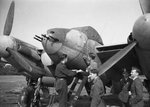Navigation
Install the app
How to install the app on iOS
Follow along with the video below to see how to install our site as a web app on your home screen.
Note: This feature may not be available in some browsers.
More options
You are using an out of date browser. It may not display this or other websites correctly.
You should upgrade or use an alternative browser.
You should upgrade or use an alternative browser.
best fighter of ww II
- Thread starter a finn
- Start date
Ad: This forum contains affiliate links to products on Amazon and eBay. More information in Terms and rules
More options
Who Replied?There were four different wing armaments with the Spitfire. A Wing was 8x .303 cal. B wing was 2x 20mm + 4x .303cal. C wing was 4x 20mm or 4x .50cal? E wing was 2x 20mm + 2 .50 cal.
I think I got them right. I can't remember about the C wing, or even if there was C wing.
I think I got them right. I can't remember about the C wing, or even if there was C wing.
lesofprimus
Brigadier General
I personally thought the E Wing was the best... Shoulda come out with that in 1941...
Lightning Guy
Master Sergeant
- 2,511
- Apr 29, 2004
As far as an armament comparison between the P-51D and the Spit, the Mustang had both A and B wings outgunned but the C or E wing Spit were supperior to the Mustang.
lesofprimus
Brigadier General
I dont know LG.... I think 6x .50 cal would be a better choice for dogfighting than 4x 20mm.... If I were going against bombers, then definatly the 4x 20mm....
Lightning Guy
Master Sergeant
- 2,511
- Apr 29, 2004
That may be the case, but it terms of muzzle energy and weight of fire, 4 x 20mm beats 6 x .50cal fairly easily.
Gemhorse
Senior Airman
The Mk.IX Spitfire was the first one to carry 0.5 Brownings...The 'Universal' wing had two 20mm gun bays, but only the inboard one was used when the mixed armament was carried. This 20mm weapon was now moved to the outboard bay, and the 0.5 in. Browning was installed in the inboard bay. With the .303 guns deleted, this change in armament meant a change in nomenclature, and the suffix 'E' was added to the Mk. number...only the 'LF and HF' models had the 0.5 in. guns......I feel the combination of 20mm and 0.5 in. machine guns were the optimum armament mixture, the 0.5 in. are virtually mini cannon anyway....anything bigger than rifle calibre has got to be a more 'decisive'-hitting round, especially against bigger aircraft [bombers]; - As in 8x.303 vs. 6x0.5 in., the latter are significantly more destructive....I'm not sure what the rate-of-fire difference is between the 20mm and 0.05 in., but even with less number of guns, I feel this was a reliable, deadly combination....Incidentally, the Spitfire Mk.IX was the first one to have the Gyro gunsight, which really helped where you were putting them 'rounds......
Attachments
Maestro
Master Sergeant
plan_D said:The Mk. VIII was better than the IX. It was the definitive Merlin-engined Spitifire. The VIII was the majority plane with the e wing, too.
That depend on the pilot. Many pilot who flew both planes thinks that the Mk. IX was better. As well as many of them thinks that the Mk. VIII was better.
Personnaly, I think the Mk. IX was better.
Gemhorse
Senior Airman
I think they were both good, one in the ETO, the other in the PTO.....After these models, they got faster but heavier and not as manoevrable, and they were both still in active service at War's end......
Lightning Guy
Master Sergeant
- 2,511
- Apr 29, 2004
Concerning the rate of fire difference between the .50cal and the 20mm, the .50cal typically put out around 750rpm while most Allied 20mm weapons were closer to 600rpm.
Gemhorse
Senior Airman
Thanks for that LG, I thought the 20mm was slower....it's a good armament combo tho', like the Lightning's....
lesofprimus
Brigadier General
The Mk II Hispano 20mm rate of fire was 600 rpm, whereas the MkV was 750 rpm.... The .303 Mk II Brownings rate of fire was 1,200 cyclic....
The Browning M2HB (Heavy Barrel) .50 cal had a cyclic rate of 550 rpm...
The M2 .50 cal was 750-850 rpm...
The Browning M2HB (Heavy Barrel) .50 cal had a cyclic rate of 550 rpm...
The M2 .50 cal was 750-850 rpm...
the lancaster kicks ass
Major General
- 19,931
- Dec 20, 2003
it's a good armament combo tho', like the Lightning's....
i prefer the mossies, 4x20mm + 4x.303............
Lightning Guy
Master Sergeant
- 2,511
- Apr 29, 2004
The 4 20mm were nice, but the .303 was clearly second rate as an air-to-air weapon in WWII.
Gemhorse
Senior Airman
Yeah, I'm not saying the .303 were useless or anything, but when you were up against heavier-armed fighters, heavy bombers and for ground and shipping attacks, a heavier machine-gun would be preferable....High rate of fire rifle-calibre is probably good for ground attacking infantry.... Afterall, they used them later in the rotary barrel affairs in Vietnam to great effect...- But I wish they'd had .50 in. in the Mossies with the cannon, that would've put some extra crunch in the firepower.....
the lancaster kicks ass
Major General
- 19,931
- Dec 20, 2003
if it's got 4x20mm you cant really say it needs extra punch, but the .303 were more usefull in ground attack, after all, it was a fighter bomber...........
Gemhorse
Senior Airman
Yeah, they were just real good with the cannons anyway, that's all the Nightfighters had....but I like .50's, had a play-around with them when I was in the Army, real munty......
Users who are viewing this thread
Total: 1 (members: 0, guests: 1)


